Introduction
The "Guppy" Ecobottle clearly stands out from the rest. With two guppies, a variety of bugs, crickets and a praying mantis, our ecobottle proves to be the best. Lots of planning occurred before the ecobottle was built. For example, our first plan was to put frogs in the terrestrial area but several conflicts rose up within the group around doing so, and group decided not to. After planning, our group proceeded to build the actual project. Once the building was done, the group had no concept of what would occur in the coming weeks with the miniature ecosystem.
The feeling of not knowing what would happen next, was an exciting motivation for our group. In the terrestrial area was a praying mantis. Our mantis lived for quite a while, surviving on both grass and crickets. In our decomposition area, we had a variety of bugs, mainly aphids. This area consisted of soil compost and leaves from trees throughout Tucson. In our aquatic area were two proud male guppies that we jokingly named 'Seigfried and Roy,' comparing them to the famous magicians.
On a daily basis, observation of the project took place. The observations were recorded in each of our group members' individual fieldbooks. We tested the pH level of the water frequently, and checked the water temperature daily. That temperature averaged around 77 degrees Fahrenheit. In conclusion, the 'breaking apart' of our ecobottle was successful. The crickets and bugs were released to live freely into the world, and Seigfreid and Roy happily went home with one of our group members. Our ecobottle was among one of the few that thrived, and in our minds, it was the best of the ecobottles in this time-consuming yet fun project!
Procedure
The Guppy Ecobottle group very carefully planned how we would build our project. Below are brief statements about our building process:
- Created a layout of how our project would look.
- Gathered all basic materials that would be needed, which included soil compost, grass seeds, Pepsi bottles, rocks, etc.
- Bought all live animals that would be put into our ecobottle, which included the guppies, crickets, bugs, and elodea, etc.
- Constructed the bottom of the ecobottle with one three-quarter-cut Pepsi bottle. Put rocks at the bottom, added water, water softener, and put in guppies.
- Got another bottle and taped 'Step 4's' bottle to it.
- Constructed the Decomposition area by: adding soil compost, and bugs into another Pepsi bottle.
- Tape 'Step 6's' bottle to the existing structure.
- Created the Terrestrial area by adding soil compost, grass seeds, crickets, and a praying mantis.
- Sealed the Eco-Bottle.
Hypotheses for our Ecobottle:
Below are our group’s hypotheses for the first five (5) days, which were September 26, 27, 28, 29, and the 30th of 2005:
- Day One
- Aquatic- All be fine
- Decomposition- All will be fine
- Terrestrial- All will be fine
- Day Two
- Aquatic- All will be fine
- Decomposition- Bugs will settle
- Terrestrial- All will be fine
- Day Three
- Aquatic- Some Elodea might be eaten
- Decomposition- Some bugs might die????
- Terrestrial- No crickets will be left
- Day Four
- Aquatic- All Elodea will be eaten
- Decomposition- All will be fine
- Terrestrial- Praying Mantis will die depending on the water and grass
- Day Five
- Aquatic- All will be fine
- Decomposition- Bugs might/will reproduce
- Terrestrial- All will be fine
Weekly Observations After Week One:
- Week Two
- Aquatic: Guppies and elodea will be alive, and water will stay somewhat clear.
- Decomposition- Leaves will turn brown, and bugs will reproduce.
- Terrestrial: Praying Mantis is alive.
- Week Three
- Aquatic- Guppies might be doing well.
- Decomposition- All will be dead.
- Terrestrial- Praying Mantis will definitely die.
- Week Four
- Aquatic- Water will smell and the Guppie's chance of living decreases.
- Decomposition- Condensation will create mold.
- Terrestrial- Some crickets might be left over.
- Week Five
- Aquatic- Algae will grow thick on the bottle.
- Decomposition- Condenstation and mold will continue.
- Terrestrial- Crickets will still live and grow really big.
Field Notebook Daily Observations:
September 29th- we noticed that our ecobottle was the best looking one. It had clear water and everything was alive and growing. The crickets were either eaten or they died but everything else was going good.
September 30th- we found two crickets. The leaves were fresh and green. We didn't see any bugs. The fish were fine and the air was circulating well. The water temperature was 86 degrees.
October 3rd- some leaves started to turn brown. The temperature of the fish water dropped down to 78 degrees. Praying mantis is alive and everything else looks good.
October 4th - All looks good. We think the bugs reproduced because there a bunch of little bugs that we did not put in there before. The fish are fine but the water got a little dirty.
October 6th- We noticed the Praying Mantis is turning white. Then it ate a cricket. The fish water is now 79 degrees.
October 7th- Some grass is growing. We found some mold in the decomposition area. We saw some bugs. The water is turning brown and the fish are still alive. The praying mantis is still alive but it is turning brown, and some algae are growing on the bottle. The water temperature is 75 degrees Fahrenheit.
October 10th - Praying mantis is still brown. some crickets were seen, the grass is growing more than we want it to, the mold is still the same, no bugs are seen, only a few leaves are green, the water is a little brown but not so bad, the water temperature is 77 degrees, some algae is growing, and the elodea is getting fuzzy. In the aquatic area, the fish are still alive but the elodea is dying. Algae are getting worse on the bottle and we think the fish are starved. The water temperature is 77 degrees Fahrenheit.
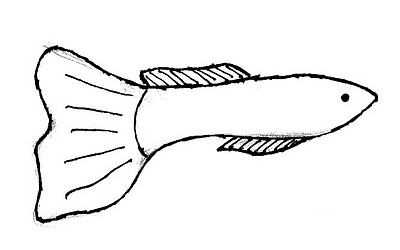
© 2005 Guppy
October 11-In the terrestrial area the praying mantis is alive, some crickets are alive and the grass did not grow anymore. In the decomposition area no bugs were seen and all the leaves are brown. In the auatic area the water is somewhat clear, fish are fine and the elodea is doing good.
October 18th- Our General impression was "everything looks OK but not at it's best." In the terrestrial area we lost our praying mantis, it died. However the crickets are still alive, and the grass grew a little bit more In the decomposition area the mold is not growing anymore and some leaves are still green. It looks a little dull though. Down in the aquatic area, the guppies are doing well. They look happy. But the elodea is fuzzy and the algae are growing. The pH level was 6 and the temperature was 77 degrees F. We added 6 ml of water.
October 21st- Our general impression was "We are proud of our project, its doing great!" Overall everything looks normal. Not much in the terrestrial area has changed except the grass has growen some more. The crickets look fine and the praying mantis is starting to dry up.In the Decomposition area all the leaves are brown, the mold did not grow anymore. In the aquatic area, the fish are great, the water temperature is 77 degrees F. and the pH level is 7.
October 27th-The grass keeps growing in the terrestrial area and the crickets are still alive. Not much condensation is in the decomposition area. The water is 77 degrees F. and the pH level is 6.
October 31st- Again, not much has changed. In the Terrestrial area the grass is somewhat dying and the crickets grew a lot! In the decomposition area, most of the leaves are brown and about 2 or 3 are green. One bug was visible. More algae are growing in the aquatic area. The guppies are still alive, the pH level is 6 and the temperature is 77 degrees F.
November 3rd- In the terrestrial area, the grass is green and yellow and the crickets are alive. Everything seems normal in the decomposition area. The water seems clear, but algae are growing on the bottle in the aquatic area. The pH level is 6 and the temperature is 77 degrees F.
Analysis
Guppy Ecobottle Analysis for pH Levels
Guppy Ecobottle Temperature Analysis

Venn Diagram Comparing Ecobottles with Another Group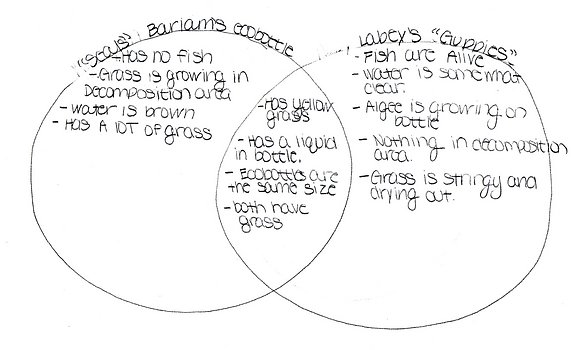
© 2005 Guppy5
Conclusion
After weeks of awaiting the results of our project, we were completely satisfied at the end. Our hard work, loving for our animals, and attentiveness to make them comfortable in temperature, paid off. We set a record at our school with this ecobottle, and that required us to plan and move ahead slowly, step by step. The Guppy group would have not done anything different! It was clear from the first day on, that we succeeded the most.
_The Guppy Group_

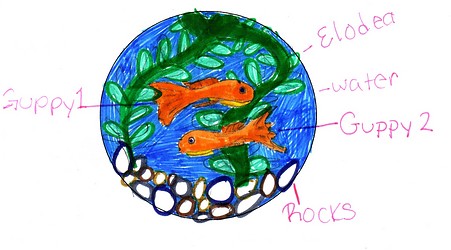
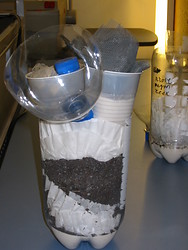
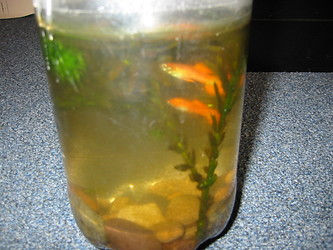
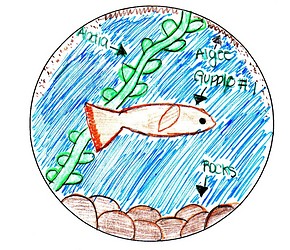
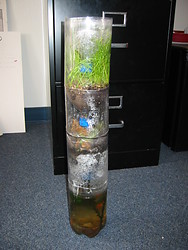
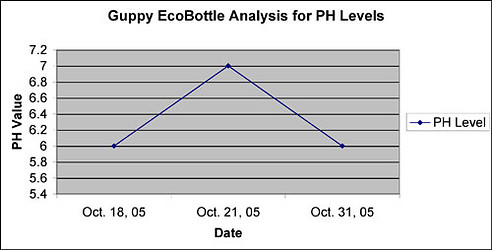
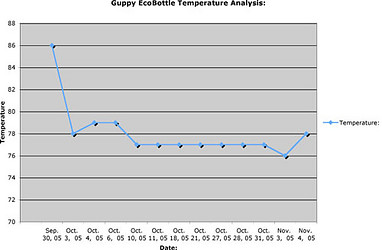


 Go to quick links
Go to quick search
Go to navigation for this section of the ToL site
Go to detailed links for the ToL site
Go to quick links
Go to quick search
Go to navigation for this section of the ToL site
Go to detailed links for the ToL site